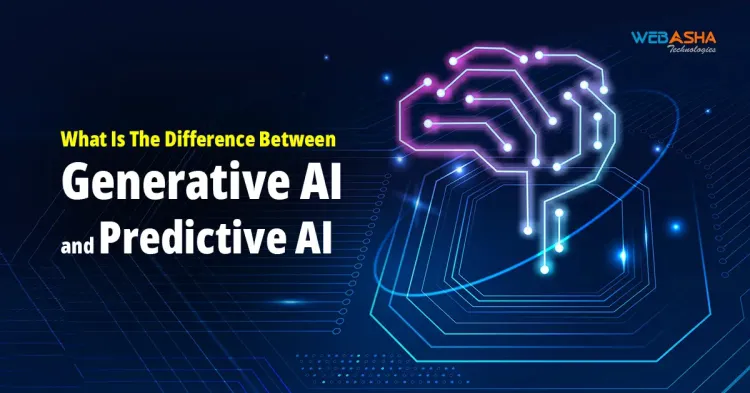What is The Difference Between Generative AI And Predictive AI
Learn the key differences between Generative AI and Predictive AI, including their definitions, features, techniques, and applications. Discover how Generative AI creates new content like text and images, while Predictive AI forecasts outcomes using historical data for decision-making.

Artificial intelligence (AI) has revolutionized many industries by offering powerful tools to solve complex problems and create new opportunities. Among the various types of AI, Generative AI and Predictive AI are two prominent subsets that serve distinct purposes. While Generative AI focuses on creating new content by learning patterns from existing data, Predictive AI aims to forecast future outcomes based on historical information. Understanding the differences between these two types of AI is crucial for selecting the right approach for your specific needs. In this article, we’ll explore the key features, techniques, and applications of Generative AI and Predictive AI to help you make informed decisions.
Generative AI
Definition:
Generative AI refers to models that create new data or content similar to the input data they were trained on. It uses algorithms to generate outputs like text, images, music, or other data types from learned patterns and structures.
Key Features:
- Creation of New Content: Generative AI is designed to produce new and unique content rather than just analyzing or predicting existing data.
- Models Used: Includes models like Generative Adversarial Networks (GANs), Variational Autoencoders (VAEs), and Transformer-based models (e.g., GPT-3, DALL-E).
- Applications: Used in creative tasks such as text generation, image synthesis, music composition, creating art, and simulating scenarios.
- Examples: ChatGPT generates text, DALL-E creates images from text prompts, and GANs generate realistic images.
Predictive AI
Definition:
Predictive AI focuses on forecasting future events or outcomes based on existing data. It uses statistical models and machine learning algorithms to make predictions.
Key Features:
- Prediction of Outcomes: Predictive AI analyzes historical data to predict future events, trends, or behaviors.
- Models Used: Includes algorithms like regression analysis, decision trees, random forests, neural networks, and time series forecasting models.
- Applications: Used in areas like fraud detection, demand forecasting, risk assessment, stock market prediction, and personalized recommendations.
- Examples: Predicting customer churn, forecasting sales, or estimating the likelihood of a loan default.
Main Differences
Purpose:
- Generative AI: Generates new data or content.
- Predictive AI: Predicts future outcomes based on historical data.
Output:
- Generative AI: Creates novel outputs that are not directly derived from the input data.
- Predictive AI: Provides predictions, classifications, or estimates based on input data.
Techniques:
- Generative AI: Uses models like GANs, VAEs, and transformers that focus on data generation.
- Predictive AI: Uses predictive modeling techniques like regression, classification, and time series analysis.
Applications:
- Generative AI: Suitable for creative tasks like content generation and design.
- Predictive AI: Suitable for decision-making and forecasting in business, finance, healthcare, etc.
Conclusion
Generative AI and Predictive AI are both transformative technologies that offer unique capabilities in the realm of artificial intelligence. While Generative AI excels in producing new and creative content, Predictive AI provides valuable insights by forecasting future events based on past data. Each type of AI has its own set of models, techniques, and applications, making them suitable for different use cases. Whether you are looking to generate realistic images, create text, or make data-driven decisions, understanding the strengths and limitations of Generative and Predictive AI can guide you in leveraging these technologies effectively. As AI continues to evolve, the complementary use of both Generative and Predictive AI can unlock even greater potential in various industries.
FAQs
1. What is Generative AI?
Generative AI refers to AI models that create new and unique content, such as text, images, or music, by learning patterns and structures from existing data. Examples include models like GPT-3, DALL-E, and GANs.
2. What is Predictive AI?
Predictive AI uses historical data to forecast future events or outcomes. It relies on statistical models and machine learning algorithms, such as regression analysis and neural networks, to make predictions.
3. How do Generative AI and Predictive AI differ?
The main difference is in their purpose: Generative AI creates new data or content, while Predictive AI forecasts outcomes based on existing data. Generative AI is used for creative tasks, while Predictive AI is used for decision-making and forecasting.
4. What are the applications of Generative AI?
Generative AI is used in text generation, image synthesis, music composition, art creation, and scenario simulation. It’s popular in creative industries and content generation.
5. What are the applications of Predictive AI?
Predictive AI is used in areas like fraud detection, demand forecasting, stock market prediction, customer behavior analysis, and risk assessment. It helps businesses and organizations make data-driven decisions.
6. Which models are commonly used in Generative AI?
Common models in Generative AI include Generative Adversarial Networks (GANs), Variational Autoencoders (VAEs), and Transformer-based models like GPT-3 and DALL-E.
7. Which models are commonly used in Predictive AI?
Predictive AI uses models like linear regression, logistic regression, decision trees, random forests, support vector machines, neural networks, and time series forecasting models.
8. Can Generative AI be used for predictions?
Generative AI is primarily designed for content creation, not predictions. However, some generative models can simulate data scenarios that may help in understanding potential outcomes, though they are not typically used for precise predictions.
9. Can Predictive AI generate content?
Predictive AI is focused on forecasting and decision-making rather than content generation. It analyzes data to make predictions rather than creating new data or content.
10. Which type of AI should I use for my project?
The choice depends on your project goals. Use Generative AI if your goal is to create new and unique content. Use Predictive AI if you need to forecast outcomes or make data-driven decisions based on historical data.












![Top 10 Ethical Hackers in the World [2025]](https://www.webasha.com/blog/uploads/images/202408/image_100x75_66c2f983c207b.webp)

![[2025] Top 100+ VAPT Interview Questions and Answers](https://www.webasha.com/blog/uploads/images/image_100x75_6512b1e4b64f7.jpg)









